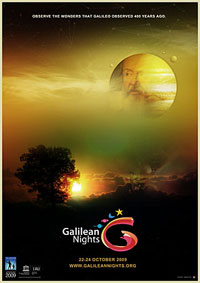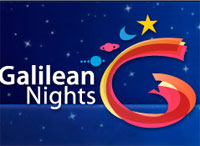Galilean Nights: 22 - 24 October 2009
Get Ready for a Galileo Experience!

- © IYA2009/J. White
- Galilean Nights Poster
The International Year of Astronomy 2009 Cornerstone project, Galilean Nights, begins on 22 October 2009.
Hundreds of thousands of people all around the world will experience their own “Galileo moment” when they look up at the sky through a telescope for the first time. Galilean Nights will be a global experience, with more than 1000 public observing events in over 70 countries, and this number is still increasing each day.
The Galilean Nights is a Cornerstone project of the International Year of Astronomy 2009 (IYA2009) and takes place from 22–24 October 2009. From stargazing in the deserts of Iran to the culinary delights of food and star parties in rural Australia, and from large observing parties in the busy capital city of Uruguay to neighbours in China studying craters on the Moon, Galilean Nights is an event for people from all walks of life, all around the globe.
Amateur astronomers, societies and other groups will be setting up telescopes in public places to allow as many people as possible to look at the heavens. Astronomy enthusiasts will be taking their telescopes to shopping centres, busy streets, schools or even the squares of capital cities. The hard work of hundreds of organisers in every country will culminate over these three days when people of all ages will share the wonders of the night sky and see the objects that Galileo first observed 400 years ago. For many, it will be their first glimpse of the marvels of the heavens through a telescope, seeing breathtaking sights such as the cloud bands of Jupiter, and intricate details on our cratered Moon.

As well as seeing our planetary neighbours through a telescope, people are encouraged to photograph what they see and share the sights with the wider world through the Galilean Nights astrophotography competition. Astrophotographers of all levels of experience are enthusiastically taking part in the competition as they try to produce their own captivating photographs of the Universe. Anybody with a camera and an appreciation of the night sky can take part!
In addition to these great activities, observatories are making their facilities available to the world, for remote observing sessions. As well as attending local Galilean Nights observing events, anybody with access to the internet will be able to control telescopes on the other side of the world. Those taking part in remote observing sessions will be able to take photographs of astronomical objects from their own personal computers.
Galilean Nights is a truly global event, with hundreds of thousands of people discovering our Universe from all sorts of locations and settings around the world. Get involved, and experience your own Galileo moment!
Related links:
:: Galilean Nights (website)
:: Galilean Nights Astrophotography Competition (More)
:: IYA2009 website (More)
:: List of Remote Observatories (More)
- Source:UNESCO SC
- 21-10-2009

